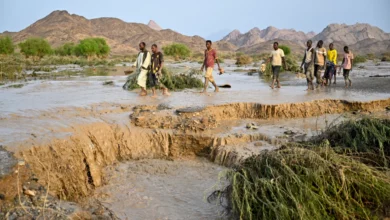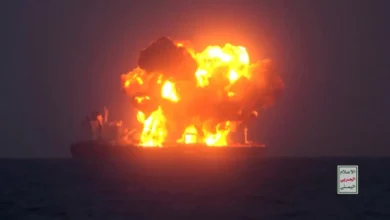
Experts are now delicately handling the 47-year-old vessel – called the FSO Safer – working to remove the crude without the tanker falling apart, the oil exploding, or a massive spill taking place.
Sitting atop The Endeavor, the salvage UN ship supervising the offloading, UN Resident and Humanitarian Coordinator for Yemen David Gressly said that the operation is estimated to cost $141 million, and is using the expertise of SMIT, the dredging and offshore contractor that helped dislodge the Ever Given ship that blocked the Suez Canal for almost a week in 2021.
Twenty-three UN member states are funding the mission, with another $16 million coming from the private sector contributors. Donors include Yemen’s largest private company, HSA Group, which pledged $1.2 million in August 2022. The UN also engaged in a unique crowdfunding effort, contributing to the pool which took a year to raise, according to Gressly.
The team is pumping between 4,000 and 5,000 barrels of oil every hour, and has so far transferred more than 120,000 barrels to the replacement vessel carrying the offloaded oil, Gressly said. The full transfer is expected to take 19 days.
The tanker was carrying a million barrels of oil. That would be enough to power up to 83,333 cars or 50,000 US homes for an entire year. The crude on board is worth around $80 million, and who gets that remains a controversial matter.
Here’s what we know so far:
Why the UN has been sounding alarms about this ‘ticking time bomb’
The ship has been abandoned in the Red Sea since 2015 and the UN has regularly warned that the “ticking time bomb” could break apart given its age and condition, or the oil it holds could explode due to the highly flammable compounds in it.
The FSO Safer held four times the amount of oil spilled by the Exxon Valdez off Alaska in 1989 which resulted in a slick that covered 1,300 miles of coastline. A potential spill from this vessel would be enough to make it the fifth largest oil spill from a tanker in history, a UN website said. The cost of cleanup of such an incident is estimated at $20 billion.
The Red Sea is a vital strategic waterway for global trade. At its southern end lies the Bab el-Mandeb strait, where nearly 9% of total seaborne-traded petroleum passes. And at its north is the Suez Canal that separates Africa from Asia. The majority of petroleum and natural gas exports from the Persian Gulf that transit the Suez Canal pass through the Bab el-Mandeb, according to the US Energy Information Administration.
The sea is also a popular diving hotspot that boasts an impressive underwater eco-system. In places its banks are dotted with tourist resorts, and its eastern shore is the site of ambitious Saudi development projects worth hundreds of billions of dollars.
A complex and risky operation
The first step of the mission was to stabilize and secure the vessel to avoid it collapsing, Gressly said. That has already been achieved in the past few weeks.
“There are a number of things that had to be done to secure the oil from exploding,” Gressly told CNN, including pumping out gases in each of the 13 compartments holding the oil. Systems for pumping were rebuilt, and some lighting was repaired.
Booms, which are temporary floating barriers used to contain marine spills, were dispersed around the vessel to capture any potential leaks.
The second step is to transfer the oil onto the replacement vessel, which is now underway.
After The Safer is emptied, it must then be cleaned to ensure no oil residue is left, Gressly said. The team will then attach a giant buoy to the replacement vessel until a decision about what to do with the oil has been made.
“The transfer of the oil to (the replacement vessel) will prevent the worst-case scenario of a catastrophic spill in the Red Sea, but it is not the end of the operation,” Gressly said.
While the hardest part of the operation would then be over, a spill could still occur. And even after the transfer, the tanker will “continue to pose an environmental threat resulting from the sticky oil residue inside the tank, especially since the tanker remains vulnerable to collapse,” the UN said, stressing that to finish the job, an extra $22 million is urgently needed.
What if a spill does occur?
A spill would shut the Yemeni ports that its impoverished people rely on for food aid and fuel, impacting 17 million people during an ongoing humanitarian crisis caused by the country’s civil war and a Saudi-led military assault on the country. Oil could bleed all the way to the African coast, damaging fish stocks for 25 years and affect up to 200,000 jobs, according to the UN.
A potential spill would cause “catastrophic” public health ramifications in Yemen and surrounding countries, according to a study by researchers at Stanford University School of Medicine. Yemen, Saudi Arabia and Eritrea would bear the brunt.
Air pollution from a spill of this magnitude would increase the risk of hospitalization for cardiovascular or respiratory disease for those very directly exposed by 530%, according to the study, which said it could cause an array of other health problems, from psychiatric to neurological issues.
“Given the scarcity of water and food in this region, it could be one of the most disastrous oil spills ever known in terms of impacts on human life,” David Rehkopf, a professor at Stanford University and senior author of the study, told CNN.
Up to 10 million people would struggle to obtain clean water, and 8 million would have their access to food supplies threatened. The Red Sea fisheries in Yemen could be “almost completely wiped out,” Rehkopf added.
The tanker has been an issue for many people in Yemen over the past few years, Gressly said. Sentiment on social media surrounding the removal of oil is very positive, as many in Yemen feel like the tanker is a “threat that’s been over their heads,” he said.
Who gets the oil?
The tanker issue remains a point of dispute between the Houthi rebels that control the north of Yemen and the internationally recognized government, the two main warring sides in the country’s civil conflict.
While the war, which saw hundreds of thousands of people killed or injured, and Yemen left in ruins, has eased of late, it is far from resolved.
Ahmed Nagi, a senior analyst for Yemen at the International Crisis Group think tank in Brussels, sees the Safer tanker issue as “an embodiment of the conflict in Yemen as a whole.”
“The government sees the Houthi militias as an illegitimate group controlling the tanker, and the Houthis do not recognize (the government),” Nagi told CNN.
The vessel was abandoned after the outbreak of the Yemeni civil war in 2015. The majority of the oil is owned by Yemeni state firm SEPOC, experts say, and there are some reports that it may be sold.
“From a technical point of view, the owner of the tanker and the oil inside it is SEPOC,” Nagi said, adding that other energy companies working in Yemen may also share ownership of the oil.
The main issue, Nagi added, is that the Safer’s headquarters are in the government-controlled Marib city, while the tanker is in an area controlled by the Houthis. The Safer is moored off the coast of the western Hodeidah province.
Discussions to determine the ownership of the oil are underway, Gressly said. The rights to the oil are unclear and there are legal issues that need to be addressed.
The UN coordinator hopes that the days needed to offload the oil will buy some time for “political and legal discussions that need to take place before the oil can be sold.”
While the UN may manage to resolve half of the issue, Nagi said, there still needs to be an understanding of the oil’s status.
“It still poses a danger if we keep it near a conflict zone,” he said.
CNN’s Eoin McSweeney and Mostafa Salem contributed to this report.




